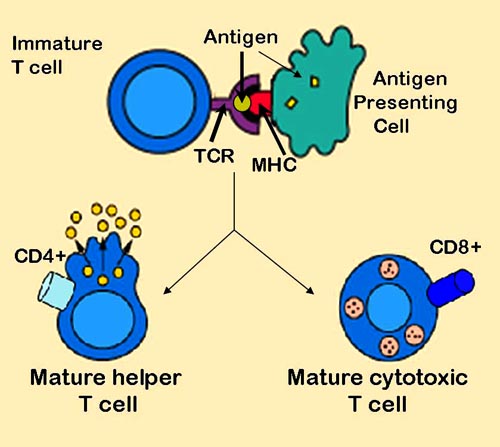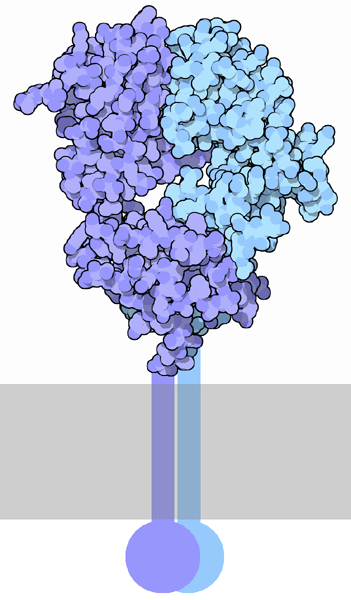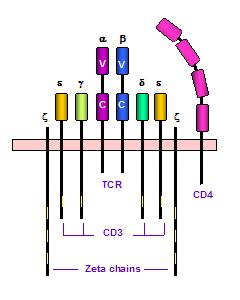T cell receptor
Template:ProteinShort Template:ProteinShort
|
WikiDoc Resources for T cell receptor |
|
Articles |
|---|
|
Most recent articles on T cell receptor Most cited articles on T cell receptor |
|
Media |
|
Powerpoint slides on T cell receptor |
|
Evidence Based Medicine |
|
Clinical Trials |
|
Ongoing Trials on T cell receptor at Clinical Trials.gov Trial results on T cell receptor Clinical Trials on T cell receptor at Google
|
|
Guidelines / Policies / Govt |
|
US National Guidelines Clearinghouse on T cell receptor NICE Guidance on T cell receptor
|
|
Books |
|
News |
|
Commentary |
|
Definitions |
|
Patient Resources / Community |
|
Patient resources on T cell receptor Discussion groups on T cell receptor Patient Handouts on T cell receptor Directions to Hospitals Treating T cell receptor Risk calculators and risk factors for T cell receptor
|
|
Healthcare Provider Resources |
|
Causes & Risk Factors for T cell receptor |
|
Continuing Medical Education (CME) |
|
International |
|
|
|
Business |
|
Experimental / Informatics |
Editor-In-Chief: C. Michael Gibson, M.S., M.D. [1]
Overview
The T cell receptor or TCR is a molecule found on the surface of T lymphocytes (or T cells) that is, in general, responsible for recognizing antigens bound to major histocompatibility complex (MHC) molecules.
It is a heterodimer consisting of an alpha and beta chain in 95% of T cells, whereas 5% of T cells have TCRs consisting of gamma and delta chains.
Engagement of the TCR with antigen and MHC results in activation of its T lymphocyte through a series of biochemical events mediated by associated enzymes, co-receptors, and specialized accessory molecules.
Structural characteristics of the TCR
Each chain of the TCR is a member of the immunoglobulin superfamily and possesses one N-terminal immunoglobulin (Ig)-variable (V) domain, one Ig-constant (C) domain, a transmembrane/cell membrane-spanning region, and a short cytoplasmic tail at the C-terminal end.
The variable domain of both the TCR α-chain and β-chain have three hypervariable or complementarity determining regions (CDRs), whereas the variable region of the β-chain has an additional area of hypervariability(HV4) that does not normally contact antigen and therefore is not considered a CDR.
CDR3 is the main CDR responsible for recognizing processed antigen, although CDR1 of the alpha chain has also been shown to interact with the N-terminal part of the antigenic peptide, whereas CDR1 of the beta chain interacts with the C-terminal part of the peptide.
CDR2 is thought to recognize the MHC. CDR4 of the β-chain is not thought to participate in antigen recognition, but has been shown to interact with superantigens.
The constant domain of the TCR domain consists of short connecting sequences in which a cysteine residue forms disulfide bonds, which forms a link between the two chains.


Generation of the TCR
Processes for TCR formation are similar to those described for B-cell antigen receptors, otherwise known as immunoglobulins.
- The TCR alpha chain is generated by VJ recombination, whereas the beta chain is generated by V(D)J recombination (both involve a somewhat random joining of gene segments to generate the complete TCR chain).
- In a similar manner, generation of the TCR gamma chain involves VJ recombination, whereas generation of the TCR delta chain occurs by V(D)J recombination.
The intersection of these specific regions (V and J for the alpha or gamma chain, V D and J for the beta or delta chain p3n15) corresponds to the CDR3 region that is important for antigen-MHC recognition (see above).
Furthermore, it is the unique combination of the segments at this region, along with palindromic and random N- and P- nucleotide additions, which accounts for the great diversity in specificity of the T cell receptor for processed antigen.
The TCR Complex
The transmembrane region of the TCR is composed of positively-charged amino acids.
It is thought that this allows the TCR to associate with other molecules like CD3, that possess three distinct chains (γ, δ, and ε) in mammals and the ζ-chain].
These accessory molecules have negatively-charged transmembrane regions and are vital to propagating the signal from the TCR into the cell; the cytoplasmic tail of the TCR is extremely short, making it unlikely to participate in signaling.
The CD3- and ζ-chains, together with the TCR, form what is known as the T cell receptor complex.

TCR Co-Receptors
The signal from the T cell complex is enhanced by simultaneous binding of the MHC molecules by a specific co-receptor.
- On helper T cells, this co-receptor is CD4 that exclusively binds the class II MHC.
- On cytotoxic T cells, this co-receptor is CD8 that is specific for class I MHC.
The co-receptor not only ensures the specificity of the TCR for the correctly-presented antigen but also allows prolonged engagement between the antigen presenting cell and the T cell and recruits essential molecules (e.g., LCK) inside the cell that are involved in the signaling of that activated T lymphocyte.
References
- Janeway CA, Jr.; et al. (2005). Immunobiology (6th ed. ed.). Garland Science. ISBN 0-443-07310-4.
- Abbas AK and Lichtman AH (2003). Cellular and Molecular Immunology (5th ed. ed.). Saunders, Philadelphia. ISBN 0-7216-0008-5.
External links
- UMich Orientation of Proteins in Membranes protein/pdbid-2hac - Zeta-zeta dimer of T cell receptor
- T-Cell+Receptor at the US National Library of Medicine Medical Subject Headings (MeSH)
See also